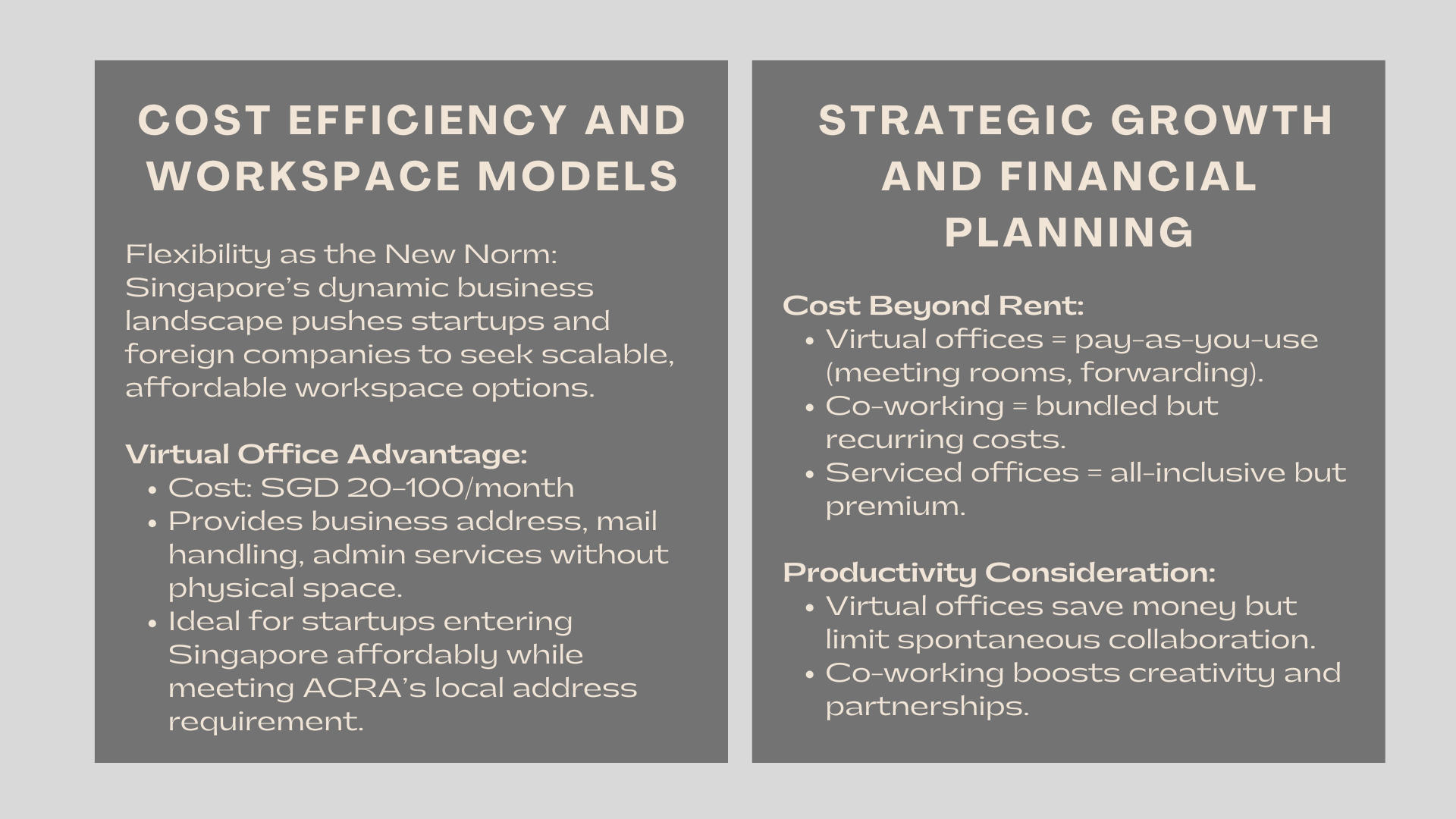Cost Comparison: Virtual Office vs Co-working Space vs Serviced Office
Introduction to Cost Comparison Virtual Office vs Co-working Space vs Serviced Office
Flexibility is now the norm in the fast changing business environment in Singapore. To the entrepreneur, business startups and growing foreign companies, the question is no longer whether to rent office space- but what type of space should be based on their operational requirements and financial constraints. A former expression of legitimacy, the traditional office lease is currently being substituted by more streamlined and affordable frameworks. The virtual offices, co-working spaces and serviced offices among them are the most feasible alternatives.
However, the workspace models are not created equal when it comes to financial sustainability. This article focuses specifically on understanding the virtual office vs coworking vs serviced office cost comparison guide, examining how each option affects a company’s bottom line, operational flexibility, and professional image. For early-stage ventures and global startups, mastering this comparison is essential to identifying affordable office space alternatives for startups and entrepreneurs that enable growth without unnecessary overhead.

1. The Financial Foundation: Understanding Cost Efficiency
1.1 The Virtual Office Advantage
The least cost model of a virtual office is available in Singapore. It offers a business address, mail handling and administration services without the need to occupy physical space. The average monthly fee is between SGD 20 and SGD 100, according to the service provider and premiums in the package. For entrepreneurs who are also exploring financial management or taking a cost analysis course in Singapore, understanding this pricing structure provides a practical example of cost efficiency in real business operations.
As an illustration, a recently established European-based fintech that needs to create a presence in Singapore can place a registration of its business with a virtual office address in the Central Business District. This meets the legal requirement of the Accounting and Corporate Regulatory Authority (ACRA) of a local registered address and the company will be in a position to operate anywhere. The outcome: total compliance and credibility at the minimum cost.
The virtual offices reduce rent, utility, and maintenance bills, which form the three most significant costs incurred in the traditional leasing of the office. In the case of startups which have limited capital, it will allow them to gain entry into the Singapore market without draining initial investment resources. It is the most basic purest type of operational efficiency: only pay what you need, when you need it.
1.2 The Co-working Middle Ground
Although the co-working space is not as cheap as the virtual office, it provides real advantages in the form of physical desks, common facilities and networking possibilities. Costs incurred on average per month vary between SGD 250 and SGD 800 depending on the provider, location and the degree of access.
A local digital agency can find a co-working facility such as JustCo or The Hive to integrate cheap rent with synergy and social togetherness. Overhead is reasonable and as the business expands, so does the work space. Nevertheless, although this sense of community and professional atmosphere is a value addition, it also brings about recurrent expenses that may burden the budgets of the early stages unless properly handled.
1.3 The Serviced Office Premium
Serviced offices are the luxury of the flexible workspace solutions and they include fully furnished, privacy-laden offices, a on-site reception, computer infrastructure and maintenance. The rates usually begin at SGD 800 and may go to SGD 2,000 per workstation every month.
This model is more appropriate to the established companies when secrecy is needed, and the company has facilities that are open to its clients, and the company is always ready to operate 24-hours. A multinational company that is entering Singapore on a regional basis, say, can choose to have a serviced office at Marina Bay Financial Centre in order to portray prestige and trustworthiness. But the financial scale is large – so it would not be appropriate to startups or businesses that are yet to test their market fit.
2. Other Cost Implications Other than Rent every month.
2.1 Unspiritualized Costs and Inclusions of Services.
Although the monthly payment is the most obvious component of office expenditure, there are hidden costs that could have a large impact on long-term budgeting. Virtual offices use extra funds in the usage of meeting rooms, extra mail forwarding, or secretarial services of the company. The amenities can be included in membership of co-working spaces, but can charge extra fees on the rooms or extra access time. The services of a serviced office are usually a combination of all utilities, cleaning facilities as well as administrative services for one premium charge.
The most important distinction here is the flexibility of control. The virtual offices are more of an on-demand model where companies are only charged what they consume as compared to co-working and serviced offices where there is a comprehensive provision of services, which makes it predictable but also adds to the recurrence costs of the business.
2.2 Costs of Alternatives and Productivity.
Cost efficiency is also associated with productivity. Although virtual office reduces costs in terms of financial commitment, it can reduce the spontaneous collaboration or networking. On the other hand, the co-working spaces promote an exchange of ideas and alliances that might fasten the business growth. Serviced offices are also more productive because they provide privacy and business facilities but at a very high price.
The decision of the appropriate model is not, however, just about cutting costs down- it is about creating efficiency in the allocation of resources to serve the aims of the business.
3. Strategic Application of Both Models.
3.1 When a Virtual Office is the Right Way to Go.
Remote-first businesses, consultants, and foreign companies exploring Singapore market would be best suited in a virtual office. It offers legitimacy, obedience and scalability without binding obligations. An example would be a SaaS company located in the United States, but has entered the Asian market and is operating remotely out of a virtual office in Singapore to handle the correspondence, receive registration with local government, as well as conduct meetings with clients in a virtual setting.
The model is especially useful to companies where agility is of utmost importance. It enables prompt market penetration and flawless business at cross time zones without the encumbrance of long-term lease agreements or workforce expenditures.
3.2 The Co-working Space is the best match.
The co-working offices serve the needs of small teamwork and entrepreneurs who appreciate flexibility yet require meeting sometimes. They are particularly required in the creative, tech, and digital industries where teamwork and exposure can lead to development.
An example of such a marketing startup could start a virtual office in six months, but after staff are hired locally, it could move to a co-working membership. This model is appealing to businesses at the transition stage because it can expand the startup capacity with the team size.
3.3 Serviced Office Becoming Necessary.
A serviced office is a great strategy to firms which want a stable and private area to work in with instant operational capability. In companies with sensitive information, client hosting and where privacy is needed, e.g. financial advisory and legal consultancy, the infrastructure and image of a serviced office is what the business needs to operate at the level it needs.
Nevertheless, the expensive nature of it overwhelm the advantages to most of the novice companies. Only once the constant revenue is obtained or funding is obtained on investment basis, it is best to shift to this model.
4. Business Development and Financial evolution.
The most sustainable alternative is to consider such workspace options as a growth continuum instead of competitors. A virtual office can be used to have a presence, and meet regulatory requirements, a startup can upgrade to a co-working space when it hires its employees and finally open a serviced office when it reaches operational maturity.
This highly artificial development guarantees financial restraint and escape premature expenditure. An example of a Singapore-based e-commerce firm would begin with a virtual address as a brand legitimate, progress to co-working with the addition of local employees, and then grow to serviced suite with a rise in regional sales.
The steps will scale the workspace costs in accordance with business scale, and hence office spending will never exceed revenue growth.
5. Strategic View: Cost as a Facilitator of Growth.
Cost management is not merely the process of selecting the least expensive alternative but it is about matching resources with strategy. Virtual office offers compliance and professionalism at a close to zero overhead at co-working, physical presence and networking. Serviced offices are expensive but help a firm to expand to a higher level of operating structure at the right time.
Singapore has a business infrastructure that is conducive to all the three models and provides a seamless route between startup and regional business. With the focus on the digital preparedness of the city, the flexibility of the leases, and the corporate provision services, even the tiny organizations are able to take advantage of the facilities of the world without any long-term contracts.
Conclusion
In a business environment where the term business agility is the measure of competitiveness, workspace selection is as strategic as it is financial. Startups and entrepreneurs have to find balance between costs and credibility, flexibility and functionality, as well as growth and discipline. Virtual office is as yet the most cost effective platform of presence creation and the co-working and serviced offices will be scalable as the operations grow.
After all, business success is not about the size of the space that a business can occupy, but how it can use that space to create value. The smart office ecosystem in Singapore enables business organizations to develop in a smart way- beginning small, developing strategically, and building confidently in one of the most favorable business-friendly environments around the globe.




